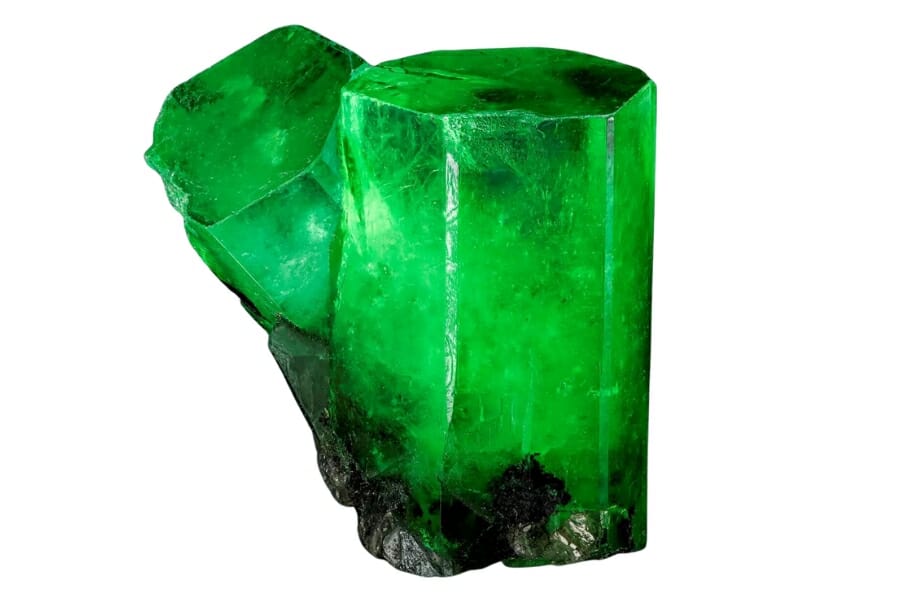Let’s go on a trip to the beautiful state of North Carolina, where the world’s best-kept secrets are waiting to dazzle us. From the majestic mountains to the charming coastal regions, it’s a geological playground brimming with a kaleidoscope of rocks, minerals, and gems that’ll leave you in awe.
The Tar Heel State boasts an impressive range of geology, flaunting everything from the lustrous mica to the illustrious gold that sparked many a treasure hunt. The broad spectrum of colors creates a canvas of Earth’s natural artwork.
Whether you want to be a geologist or someone who marvels at the Earth’s geological wonders, our state’s remarkable variety of rocks, minerals, and gems is a true testament to the beauty beneath our feet.
Get ready to unearth the magic that nature has been quietly crafting for millions of years.
A List of The Common Rocks, Stones, and Minerals Found in North Carolina
First, we’ll talk about some of the rocks and minerals found most often in the state. Check out the following articles, where we go into a lot of detail if you want a complete guide.
The North Carolina State Rock, Mineral, and Gem
Before we get into the details, it’s helpful to know what rock, mineral, and gem represent our state:
| North Carolina State Rock | Granite |
| North Carolina State Mineral | Gold |
| North Carolina State Gem | Emerald |
You can learn more about the state’s geology by visiting the North Carolina Department of Environmental Quality (DEQ) website before heading out on your collecting adventure.
Always Confirm Access and Collection Rules!
Before heading out to any of the locations on our list you need to confirm access requirements and collection rules for both public and private locations directly with the location. We haven’t personally verified every location and the access requirements and collection rules often change without notice.
Many of the locations we mention will not allow collecting but are still great places for those who love to find beautiful rocks and minerals in the wild without keeping them. We also can’t guarantee you will find anything in these locations since they are constantly changing.
Always get updated information directly from the source ahead of time to ensure responsible rockhounding. If you want even more current options it’s always a good idea to contact local rock and mineral clubs and groups
Chrysocolla
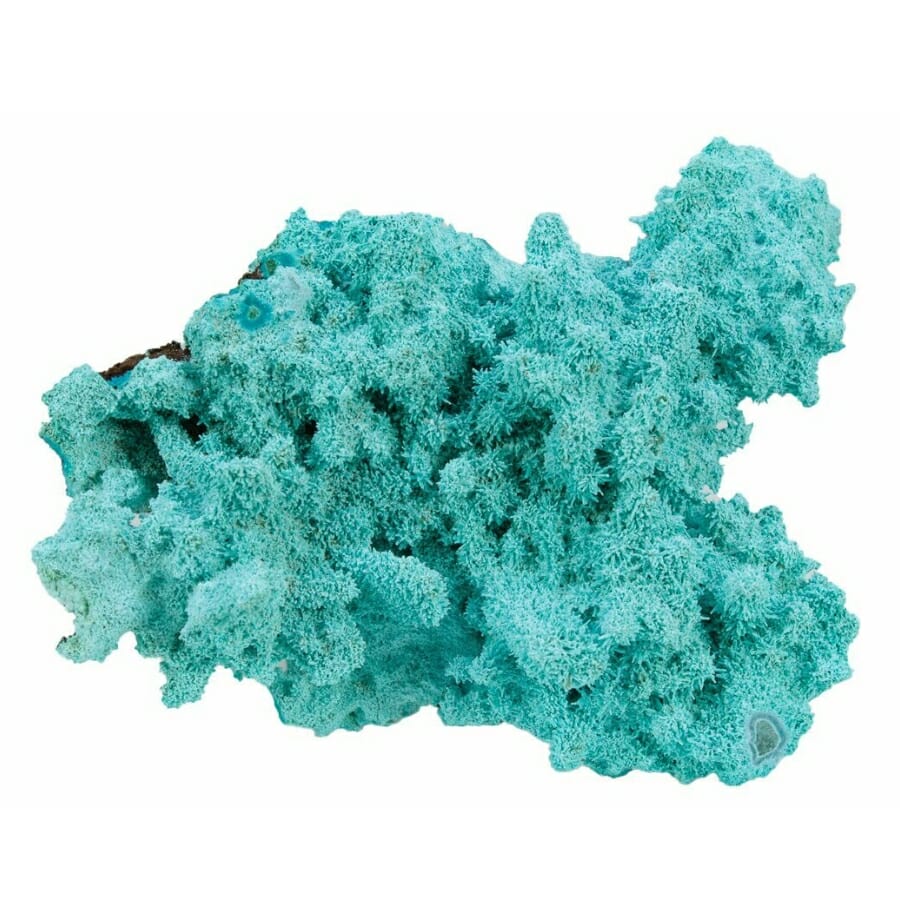
Chrysocolla is a real treasure in the world of rocks and minerals. It stands out because of its bright blue-green color, which makes people think of tropical seas and lush forests.
This stunning mineral is born when copper ores meet water. Imagine water dancing over and flowing through rocks rich in copper. As they come into contact, the water breaks down the copper, making the beautiful chrysocolla.
Ancient people liked its beauty and used it to make jewelry and art. Recently, it has become a popular material for lapidaries and jewelry makers.
Because of its bright colors and decorative patterns, it’s often used to make one-of-a-kind jewelry, from tiny pendants to big rings.
Chrysocolla is a beautiful stone that shows how nature’s chemistry works and tells stories from places as cool as North Carolina.
Where you can find Chrysocolla in North Carolina
Chrysocolla specimens are found in the following areas in North Carolina:
- At the Bear Creek in Chatham County
- Gardner Mine
- Mills Hill Mine
- Sheepcliff Mine
- Wolf Creek Mine
Dolomite
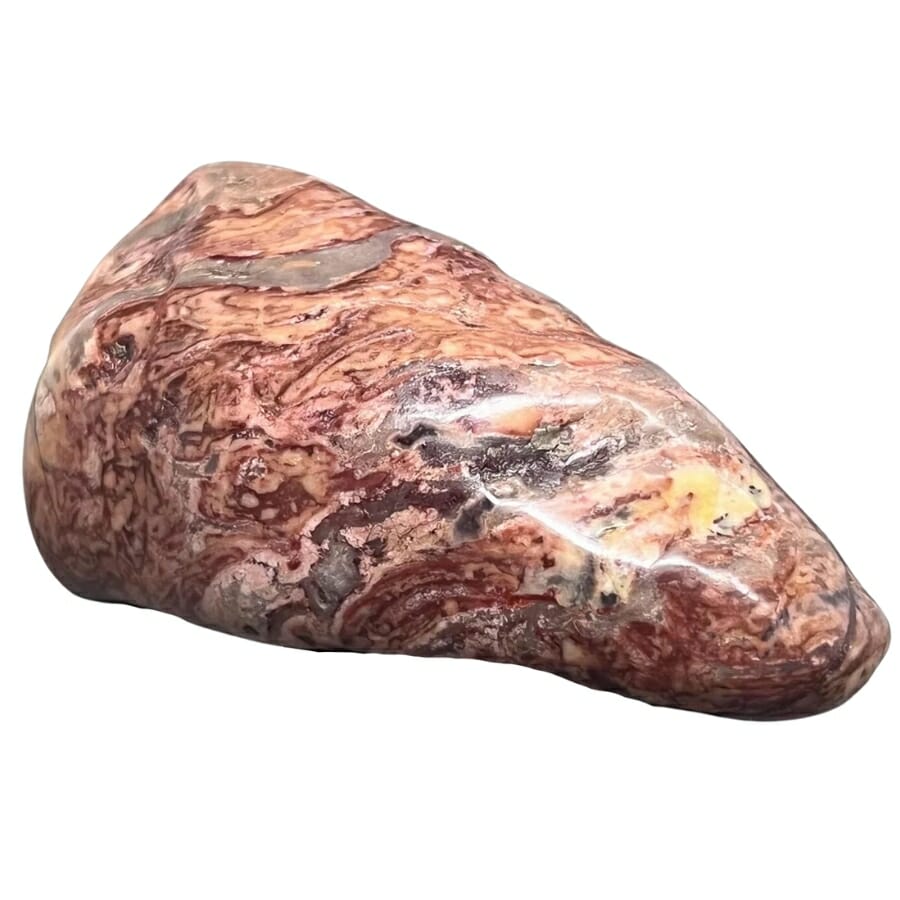
Dolomite is an awesome mineral that holds some neat secrets! It has a soft, white or light pink hue, making it stand out in the world of rocks. This mineral is pretty special because it can be both a mineral and a gem.
When we talk about the mineral, we talk about the tiny crystals that make up the rock. And when we talk about the rock, it’s a bunch of those crystals packed together.
Dolomite starts its life as limestone. This limestone changes with the right amount of water, magnesium, and time. Some of the limestone’s ingredients switch places with the magnesium.
Its beauty is undeniable. That soft color makes it perfect for decorative stones and building materials. Its also a favorite among sculptors and architects because it can be used to make beautiful works of art and elegant buildings.
Farmers also like it because when they crush it up and spread it on their fields, it helps neutralize acidic soil, making it easier to grow healthy crops.
Dolomite is a valuable mineral used in art, building, and farming. It makes our surroundings more beautiful and helps build our modern world.
In the big picture, Dolomite is a reminder of nature’s power to change and adapt. It’s a mineral that starts as one thing, transforms into another, and offers so much value along the way!
Where you can find Dolomite in North Carolina
Dolomite deposits can be found at many old area mines in Hiddenite town.
Feldspar
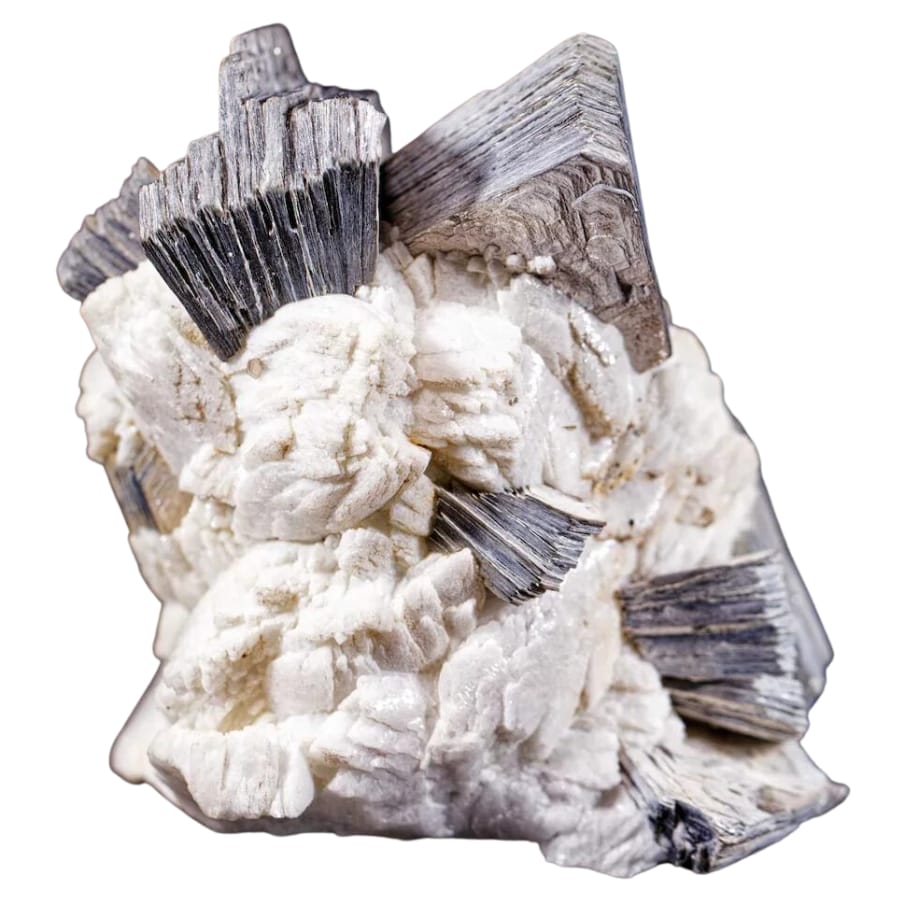
Feldspar is a rock star in the mineral world! It comes in many cool colors like pink, white, or clear. If you’ve ever looked at a granite countertop or walked on a sandy beach, you’ve probably seen feldspar without knowing it! The mineral is all around us.
Magma, a holt molten rock, cools down deep inside the Earth. As it cools, different minerals begin to crystallize or form solid bits, and one of the first to pop up is feldspar. Over a long time, this magma rises to the surface of the Earth, bringing feldspar with it.
It’s a key ingredient in making things like glass and ceramics. That bowl of cereal you had this morning? It might’ve been in a ceramic bowl made with the help of feldspar. And those shiny sparkles you see in some rocks? Yep, that’s often feldspar catching the light just right.
In the end, feldspar is more than just a pretty face. It plays a big part in our daily lives, from the things we use to the ground we walk on. It truly is an unsung hero in the world of minerals!
Where you can find Feldspar in North Carolina
There are several places in North Carolina where you can find feldspar, such as:
- Kyanite mines at Yancy County
- Lost River Gold
- Mountain Mine
- South Mountains
Monazite
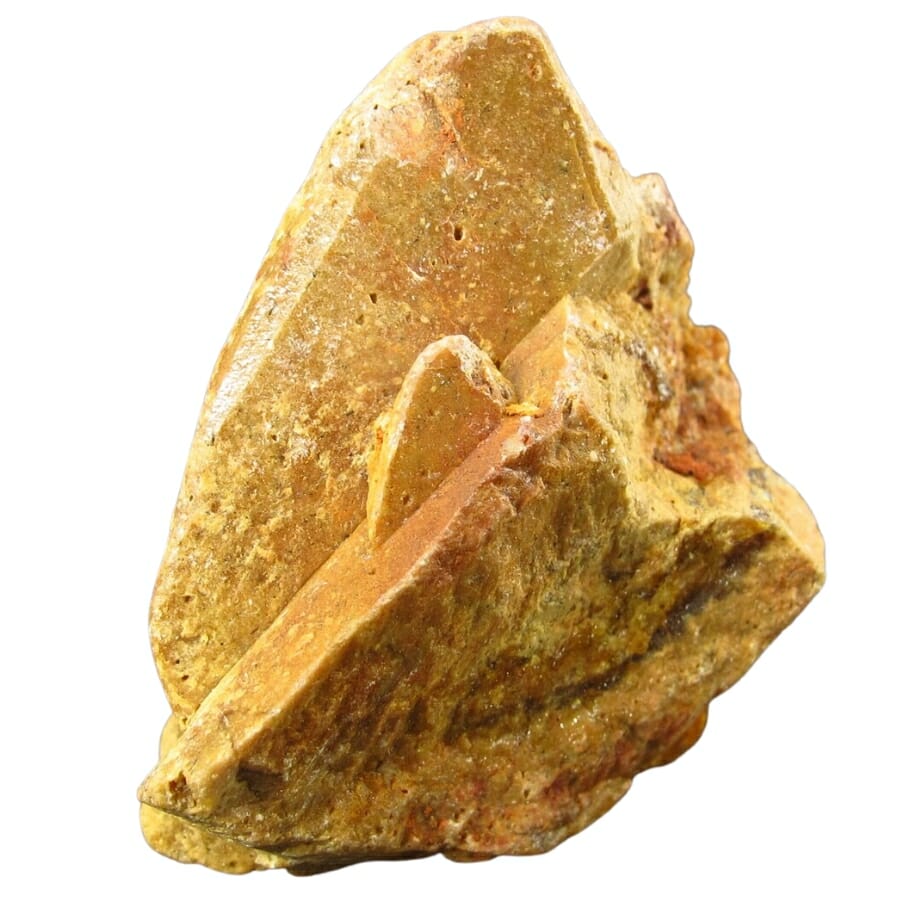
Monazite is a real gem in the mineral kingdom, not just because it sounds fancy! This mineral stands out because it is a rich brown to reddish brown color, and sometimes even yellow or green.
Monazite forms in rocks changed by heat and pressure deep in the Earth. This process is called “metamorphosis. “Sometimes, it also forms in sands carried by rivers from these metamorphic rocks. As these sands and rocks shift over time, monazite patiently grows, crystal by crystal.
This mineral is super valuable because it contains rare earth elements. These are special elements used in many modern gadgets and technologies.
Think smartphones, computers, and even some green technologies like wind turbines. So, whenever you’re texting or watching videos on your phone, you might have to thank it in a way!
Plus, it has another neat feature. It has a unique ability to “record” time. Scientists can look at the mineral and figure out how old it is, giving them clues about Earth’s history.
Monazite is more than just a brown or reddish stone. It’s a timekeeper and a key player in modern tech, making our world both smarter and more colorful!
Where you can find Monazite in North Carolina
Monazite is common in North Carolina, especially in the general area of Stony Point.
Pyrophyllite
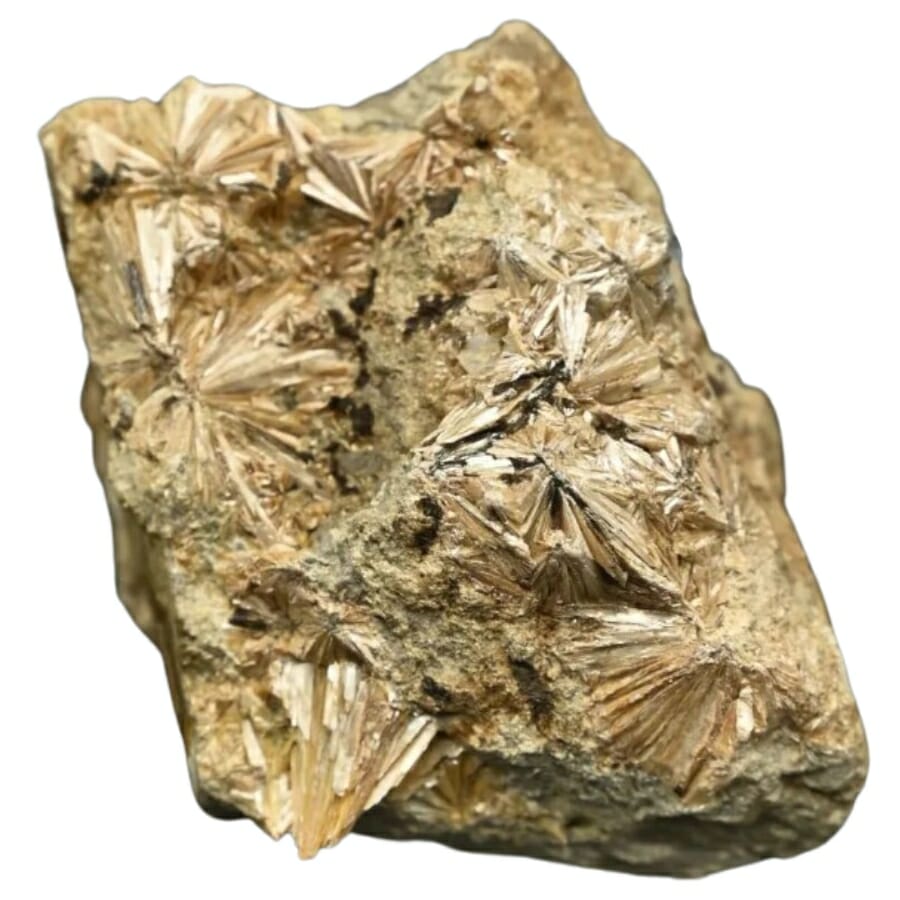
Pyrophyllite is a cool-sounding name for an even cooler mineral. It’s usually a pale, silvery-white or sometimes even a soft shade of green. Touching it feels like touching talc, because it’s smooth and even slippery!
The story of how pyrophyllite was made begins deep inside the Earth. It forms in rocks that have been changed by heat and pressure. These rocks are called metamorphic rocks.
Some clays change into this mineral after being pushed deeper into the Earth and being exposed to heat and pressure for a long time.
Artists and sculptors love it because it’s soft and easy to carve into detailed shapes. Imagine creating stunning art pieces out of this shiny, silvery stone! Also, pyrophyllite has a unique property: it is resistant to high temperatures.
This makes it very useful in industries that need materials that can handle heat, like ceramics and materials that keep heat out.
Pyrophyllite isn’t just a pretty face in the rock world. From art to industry, this mineral is a superstar. It dazzles with its look, feels interesting to touch, and stands tough against high heat. Talk about an all-rounder in the mineral family!
Where you can find Pyrophyllite in North Carolina
You can find many different pyrophyllite specimens at:
- Bowling’s Mountain Mine
- Glendon area mines
- Linville Mountain
Talc

Talc is a true superstar in the mineral world! This mineral is soft, so soft in fact, that you can easily scratch it with your fingernail. It has a smooth, almost soapy feel, so some call it “soapstone” when it forms into large chunks.
It forms when magnesium, silica, and water mix just the right way in certain rocks. Over time, these ingredients bond with heat and pressure, and we get talc!
This mineral has some fantastic uses. First up, cosmetics. Talc helps give makeup that smooth texture that glides on the skin. Think about face powders and eyeshadows; many have talc in them.
But wait, there’s more! Talc is also used in industries. It keeps plastics strong, makes paints easy to spread, and is even used to make some kinds of rubber. Who could also forget baby powder? For years, Talc was the main ingredient in many baby powders because it felt silky and soaked up moisture.
In the grand scheme of things, talc is both practical and luxurious. It’s found in everyday products and also adds a touch of smoothness to our lives. Truly, talc is a mineral that touches us in more ways than one!
Where you can find Talc in North Carolina
There are a lot of talc deposits in North Carolina, especially in the following places:
- Area Spruce Pine
- The general area of Ivy Creek
- Wilkesboro area
Unakite
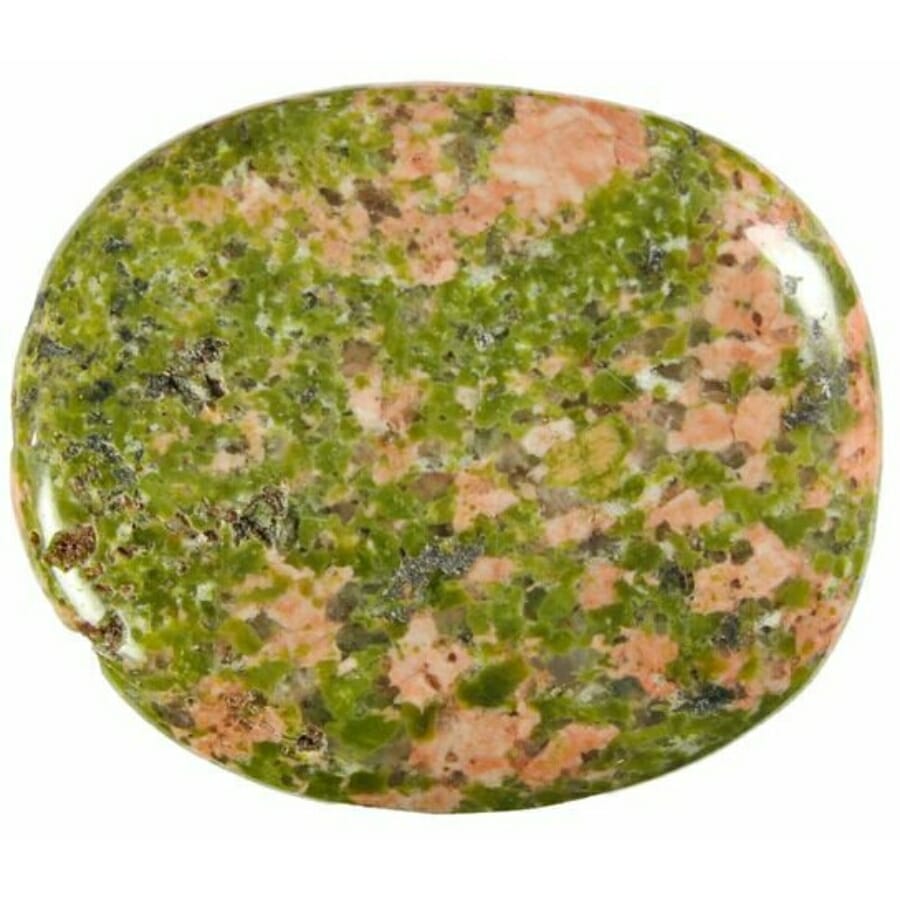
Unakite is a mineral that steals the show. Imagine a rock that has beautiful pink feldspar, clear quartz, and bright green epidote all mixed. This gorgeous mix gives the mineral its distinctive speckled green and pink look.
It forms when granite rocks change due to heat, pressure, or hot fluids. Minerals like feldspar were there before the change and mixed with the new minerals like epidote. This transformation gives birth to a unique blend of colors in it.
People value unakite for several cool reasons. For one, its bright and colorful appearance makes it super popular for making jewelry.
Beads, pendants, or even earrings made of unakite can be a statement piece! It’s also used for decorative items, like bowls or carvings, adding a natural color to any space.
All in all, unakite is a blend of beauty and mystery. Whether worn as jewelry or displayed as art, this rock never fails to capture attention!
Where you can find Unakite in North Carolina
There are several spots to find unakite in the places below:
- Area outcrops and mining dumps of Cranberry
- Birch Mine
- Marlin Knobs
- Roan Mountain area outcrops
- Roaring Fork Creek
The Gemstones Found In North Carolina
Now it’s time to talk more about the precious gems you can find in North Carolina. If you want a complete guide, we’ve also made a list of the very detailed articles we’ve written:
Aquamarine
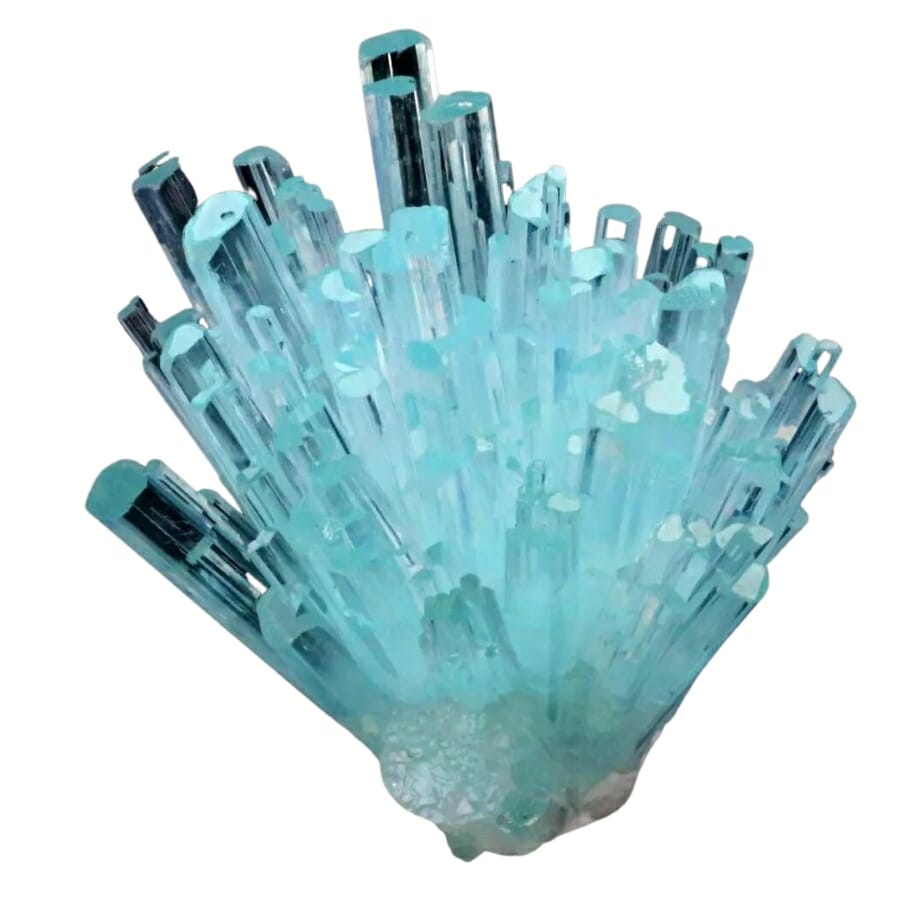
Aquamarine is a true treasure from the heart of the Earth! This gemstone is a dreamy blue to greenish-blue color that reminds you of clear, tropical oceans. The name “aquamarine” comes from two Latin words: “aqua” meaning water, and “marina” meaning sea. A pretty fitting name, right?
This stunning gem is part of the beryl family, which means it’s related to emeralds. These minerals form when molten rock deep in the Earth cools under certain conditions.
Aquamarine crystals grow with the right amount of beryllium, aluminum, and silicate. Over time, traces of iron sneak in, giving this gem its enchanting blue hue.
Its beautiful color and clarity make it a top choice for jewelry. Rings, necklaces, earrings – aquamarine shines in all of them! Its clear blue reminds many of calm seas and clear skies, making it a favorite for those who love ocean vibes.
In essence, aquamarine combines the mysteries of the Earth with the allure of the sea. Wearing or owning this gemstone feels like holding a tiny piece of the ocean’s heart!
Where you can find Aquamarine in North Carolina
You can visit these places to find aquamarine in the state:
- Crystal Ridge
- Escondido Canyon
- Shelter Cove
Azurite
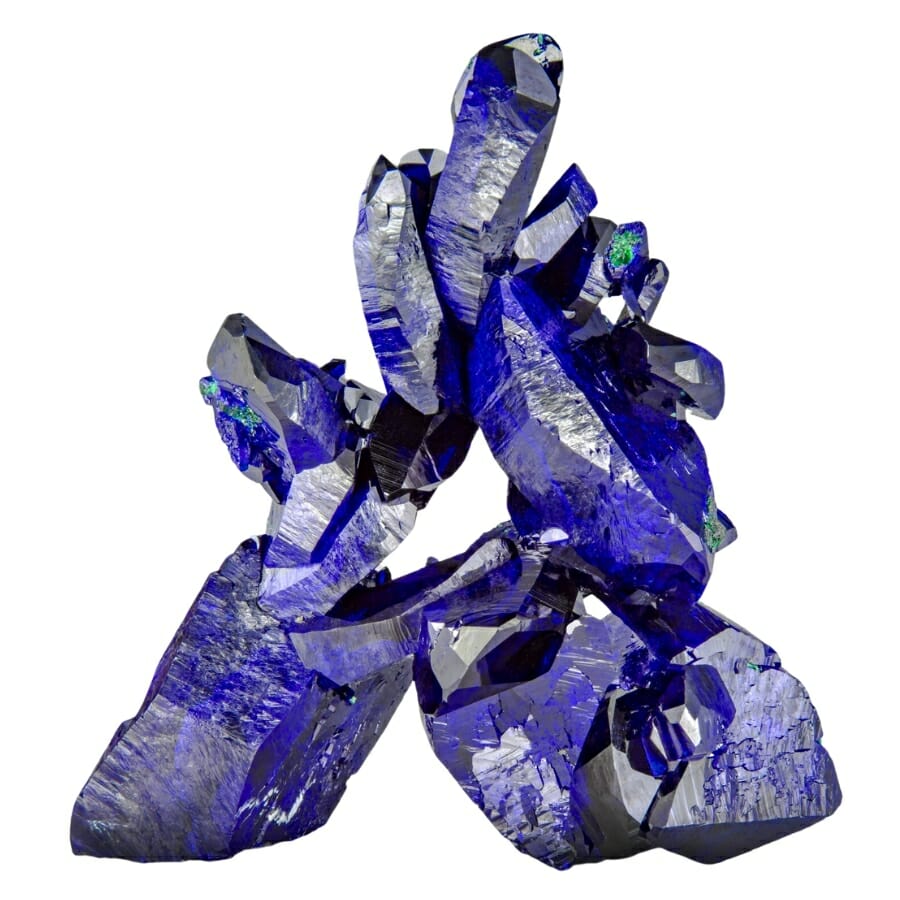
Azurite is a total dazzler! Its name comes from the Persian word “lazhward,” which means “blue.” Its deep, bright blue color makes it easy to see why. People used to grind this gem into a fine powder and mix it with paint to make it bright blue.
Here’s a fun fact! Azurite is basically blue copper. Well, not exactly, but it does happen when water, carbon dioxide, and copper mix. When these elements react, they create this beautiful blue mineral.
Beyond its stunning appearance, it has been treasured for centuries. Artists, as mentioned, loved the rich blue hue it gave to their paintings. It’s a favorite among gem and mineral collectors today.
When you look at it, you can see the history of our planet and the magic that happens when elements come together in the most beautiful ways. Whether in a piece of jewelry or a rock collection, azurite shines bright as a reminder of how amazing nature is.
Where you can find Azurite in North Carolina
Azurite can be found all over North Carolina, especially in the following places:
- Bennett area mines and prospects
- Elk Knob
- Old area mines of Eldorado
- Reed Gold Mine
Chrysoprase
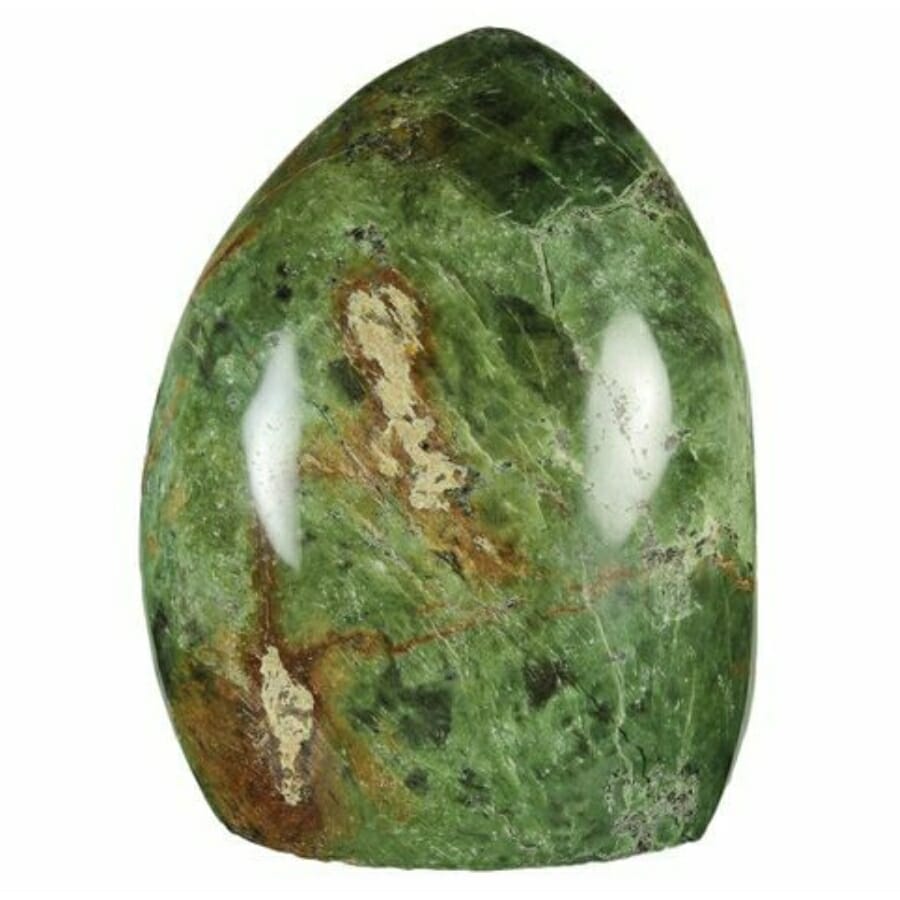
Chrysoprase is a real gem, literally and figuratively! Imagine the fresh green of young leaves or the vibrant color of green apples. That’s the captivating hue of chrysoprase, making it a standout in the gem world.
This stone belongs to the chalcedony family, and nickel gives it its unique green color. It comes from the tiny amounts of nickel mixed with the chalcedony.
People have been smitten with chrysoprase for a long time. Ancient civilizations used it in jewelry and decorations. Fast forward to today, and it’s still a hit!
Jewelers love it because that lush green makes a piece look elegant and lively. It’s often made into beads, cabochons, or very detailed carvings.
In essence, chrysoprase is a delightful combination of Earth’s artistry and ancient stories. Whether we wear it as a necklace or a treasured stone, it brings a touch of nature and history into our lives.
Where you can find Chrysoprase in North Carolina
Chrysoprase can be found in places such as:
- Lookout Mountain
- Pisgah Mountain
- Sugar Mountain
- Walker’s Knob
Cuprite
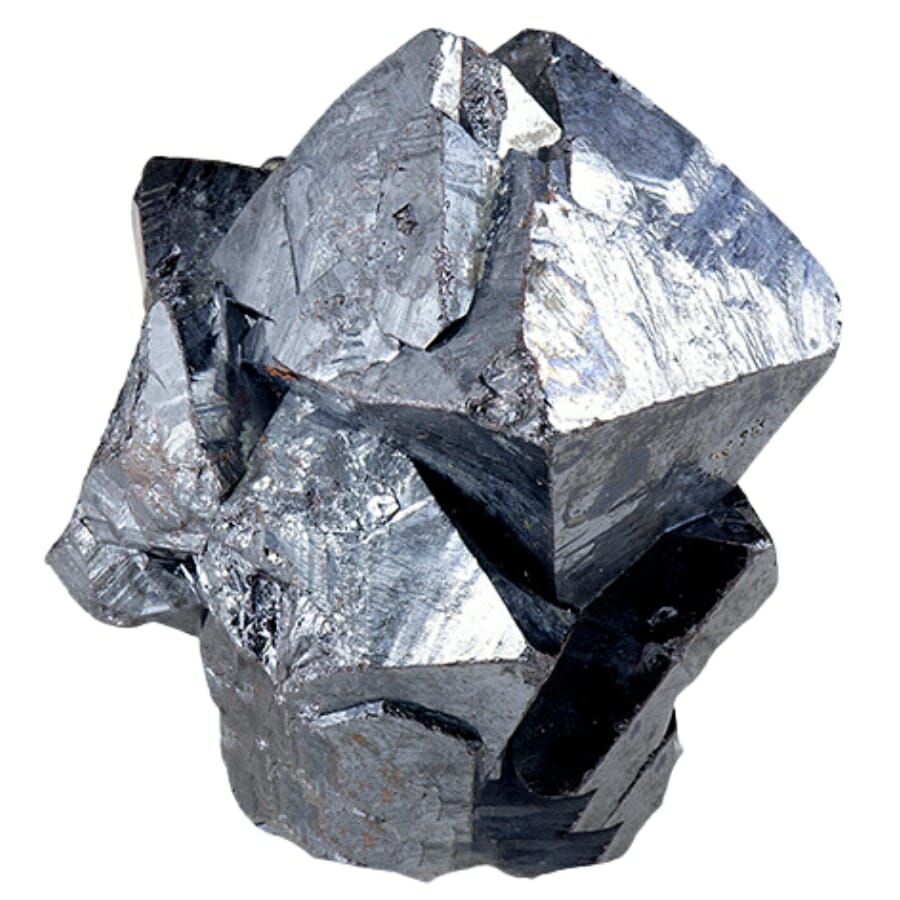
Picture a gem that shines with a deep red hue, almost like it’s holding a tiny fire inside. That’s cuprite, and it’s a sight to behold.
Here’s a remarkable fact: cuprite has much to do with copper. It forms when copper reacts with oxygen. So, in a way, you could say cuprite is what happens when copper takes a deep breath!
Its intense color is a showstopper. This makes it a prized find for mineral collectors. They always look for a perfect, shiny piece of this mineral to show off in their collections.
Then there’s the practical side of things. It has a high copper content. This means it can be a valuable source of copper metal. So, people mine it, not just because it looks pretty, but because it’s practical too!
Cuprite is a reminder of how amazing things can happen when the right parts of nature come together. It never fails to impress, whether you’re looking at its fiery glow or taking the copper out of it.
Where you can find Cuprite in North Carolina
Cuprite is abundant in North Carolina, especially in the places listed below:
- Many area mines in Davidson County
- Mine dumps near Elk Creek in Stratford
- Reed Gold Mine
Opal
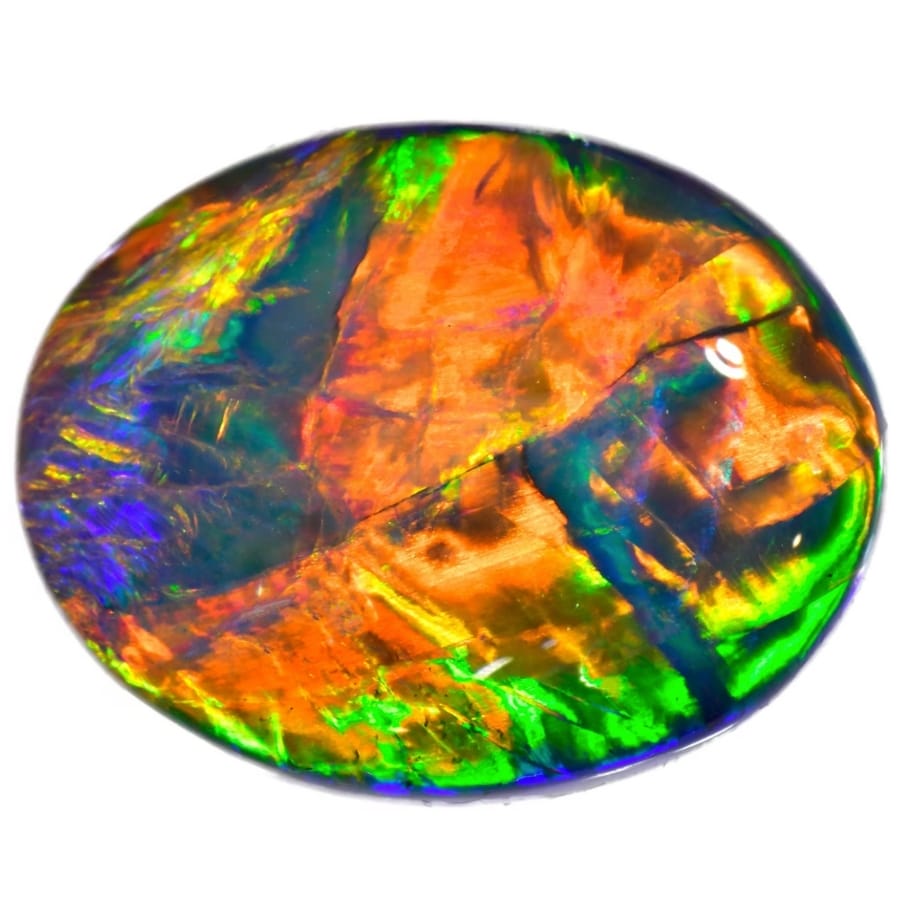
Opal unveils a world of iridescence and wonder that captures the eye and imagination. Composed of silica and water, opal’s formation is a delicate dance of geology and light.
It comes out of holes in old rocks, where water and silica mix in a way that uniquely combines chemistry and art. As water seeps into cracks and space in rock formations, it takes the dissolved silica and forms into opal.
Opal’s iridescence is caused by how the silica spheres are arranged in this lattice. When light passes through these, it bends and scatters, making a beautiful play of colors like rainbows and galaxies.
It shows that Earth can make art by making a gemstone that magically catches and reflects light.
The way opal looks makes it valuable. It connects us to the hidden beauty of the Earth and shows us how many colors there are in the universe.
Where you can find Opal in North Carolina
Opal can be found in a lot of places in North Carolina, especially in the following places:
- Cape Fear River
- Deer Park Mine
- Elijah Mountain Gem Mine
- Higdon Mountain
- Stream gravels and fields to Harrisburg
Ruby
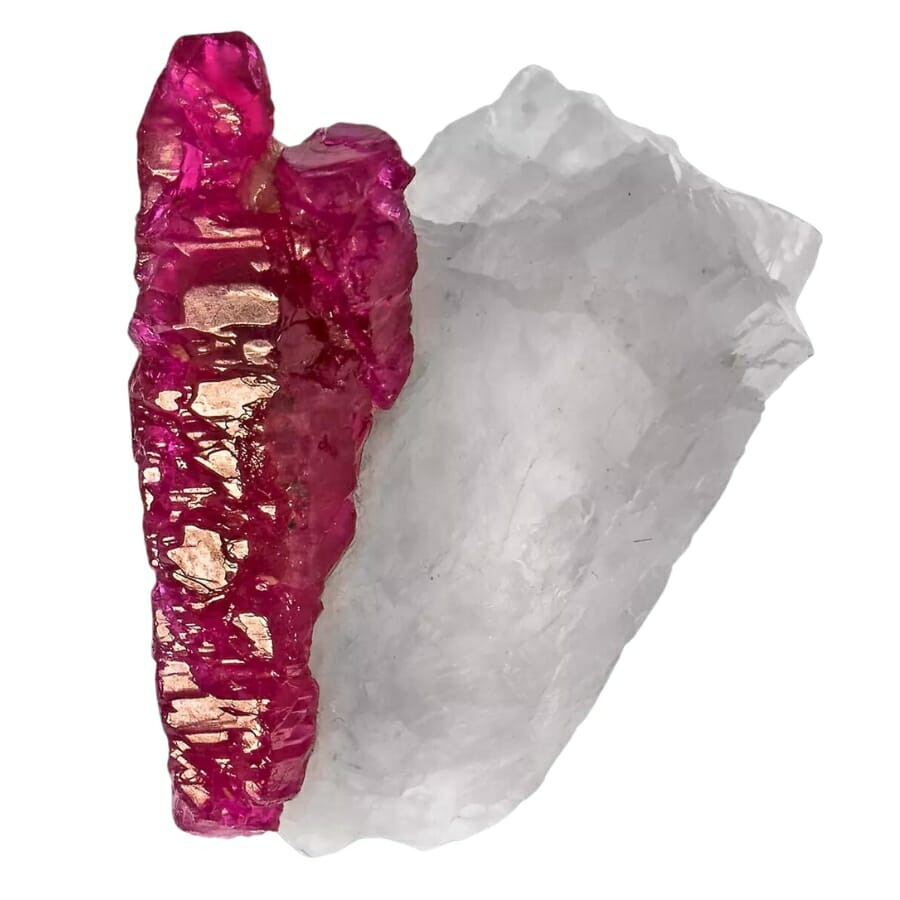
Ruby is a true gem, and not just because it’s considered one of the precious stones! This beauty shines with vibrant red, ranging from pinkish tones to deep, blood red.
The name “ruby” comes from the Latin word “ruber”, which means red. So, when you think of a ruby, think of fiery passion and intense color!
Here’s the magic behind its formation: rubies comprise a mineral called corundum. On its own, corundum is pretty much colorless. But when tiny amounts of chromium get mixed in, the magic happens! The chromium gives the mineral its iconic red glow.
Its gorgeous red color makes it a favorite for jewelry. Think of all the stunning ruby rings, necklaces, and earrings you’ve seen.
Because of its hardness, second only to diamond, it’s perfect for everyday wear. It also has a rich history. Kings and queens have worn them both in the past and present.
It represents deep love, history, and some of nature’s magic. Ruby is still a valuable and timeless symbol of beauty and strength that continues to inspire and captivate.
Where you can find Ruby in North Carolina
Ruby is abundant in North Carolina, mainly in the following areas:
- Corundum Hill
- Gem Mountain Gemstone Mine
- Rose Creek Mine
- Sheffield Gem Mine
- Thermal City Gold Mine
Scheelite
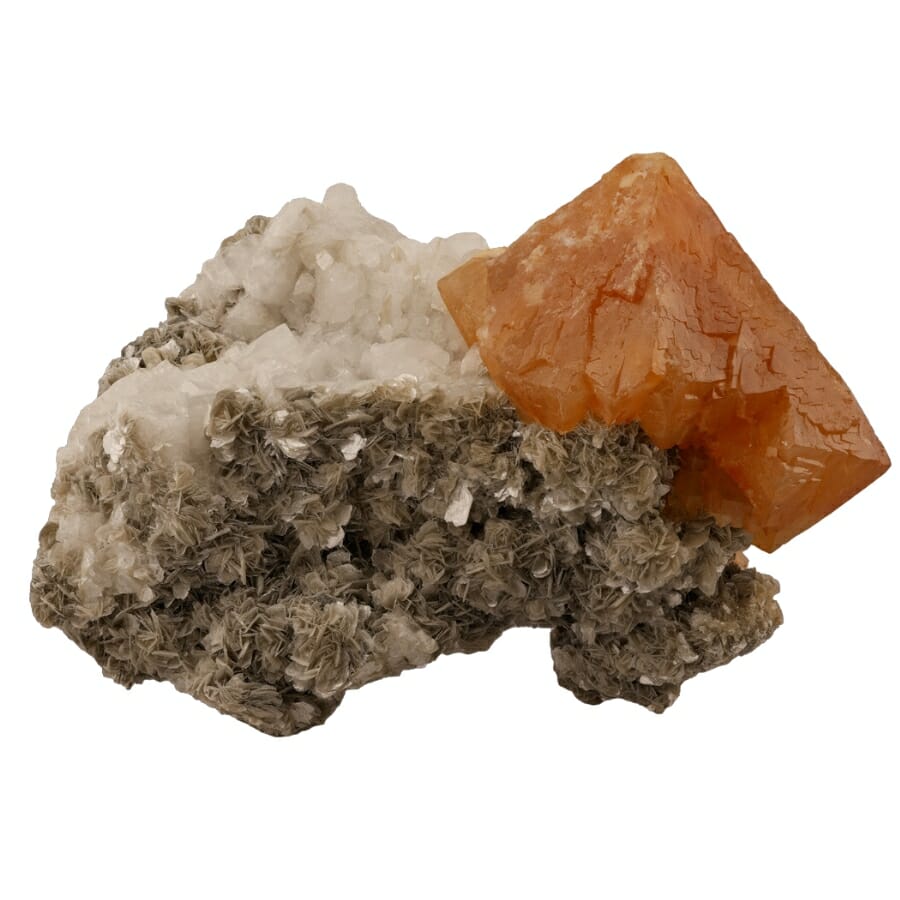
Scheelite is an absolute wonder in the mineral world! First, when you spot this gemstone, you’ll often see vibrant colors. It can shimmer in whites, yellows, oranges, and even browns.
This gem is extra special. It can glow bright blue or white under ultraviolet light, a beautiful sight.
Scheelite forms in high-temperature veins of rocks and sometimes in granite pegmatites. This means it often forms in hot fluids underground, which harden as they cool. It’s mostly made up of calcium and tungsten combined with oxygen.
Beyond its glowing beauty, it’s a significant source of tungsten. Tungsten is a solid metal used in many things, like the filaments of light bulbs and tools that need to last a long time.
In short, scheelite is a feast for the eyes and an industry workhorse. It’s a perfect example of how nature blends beauty with usefulness. The next time you see something made of tungsten, remember the incredible scheelite that made it possible!
Where you can find Scheelite in North Carolina
You can find a lot of scheelite in North Carolina, particularly in these places:
- Area mines to Little Island Creek
- Reed Gold Mine
The Crystals Found In North Carolina
In North Carolina, you can find a lot of beautiful crystals that are very valuable to collectors and crystal enthusiasts. We’ve told you a lot about these crystals down below.
You can also read our article about where to find crystals in North Carolina:
Amazonite
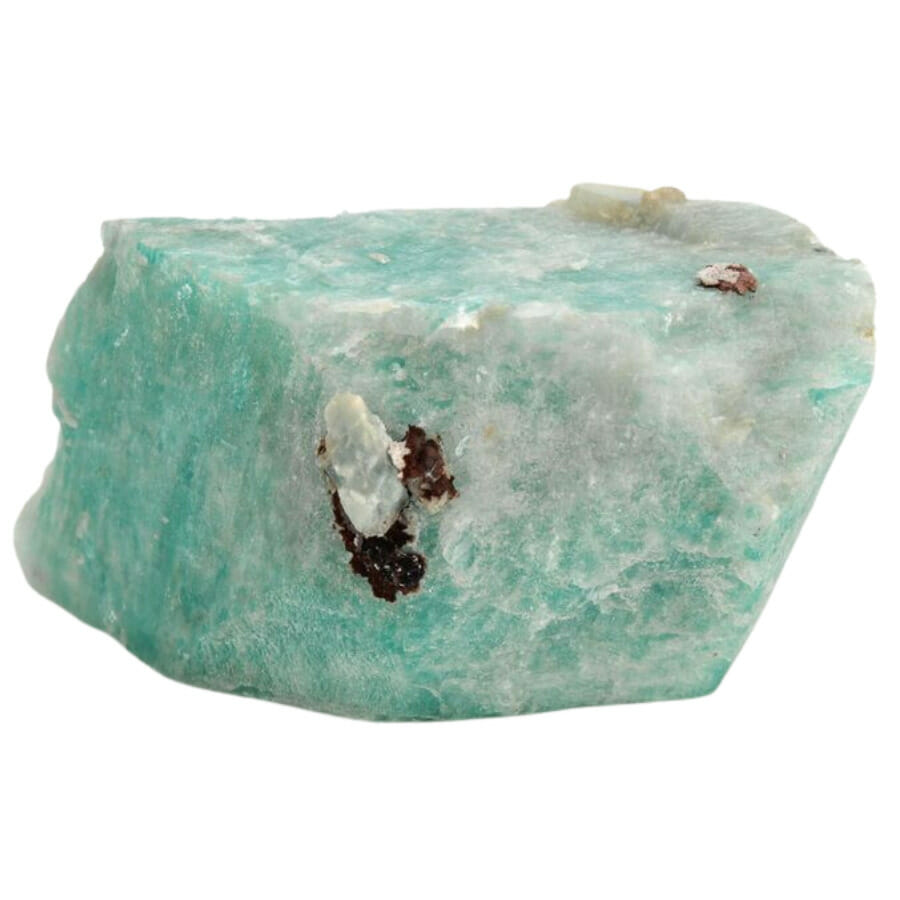
Amazonite is a real showstopper with its stunning turquoise-green color! Its calming shade is a reminder of tropical waters or serene forests. It’s named after the Amazon River, even though there’s no proof it was found there. Just think of a vast river and lush rainforest when you imagine its color.
It belongs to the feldspar family, a group of minerals that can be found in many rocks around the world. Amazonite forms in granite and pegmatites. It also gets its color when certain conditions happen deep within the Earth.
Beyond its eye-catching color, it has been used for thousands of years. Ancient civilizations crafted it into jewelry, beads, and other ornamental items. Many jewelry designers still love using it for its natural beauty and soothing color.
Amazonite’s peaceful colors remind us of the beauty of nature on Earth. At the same time, the fact that it’s still valuable and popular shows that it will never go out of style.
Where you can find Amazonite in North Carolina
Amazonite is easy to find in North Carolina, specifically in these locations:
- Elijah Mountain Gem Mine
- Ray Mica Mine
- Spruce Pine
Barite
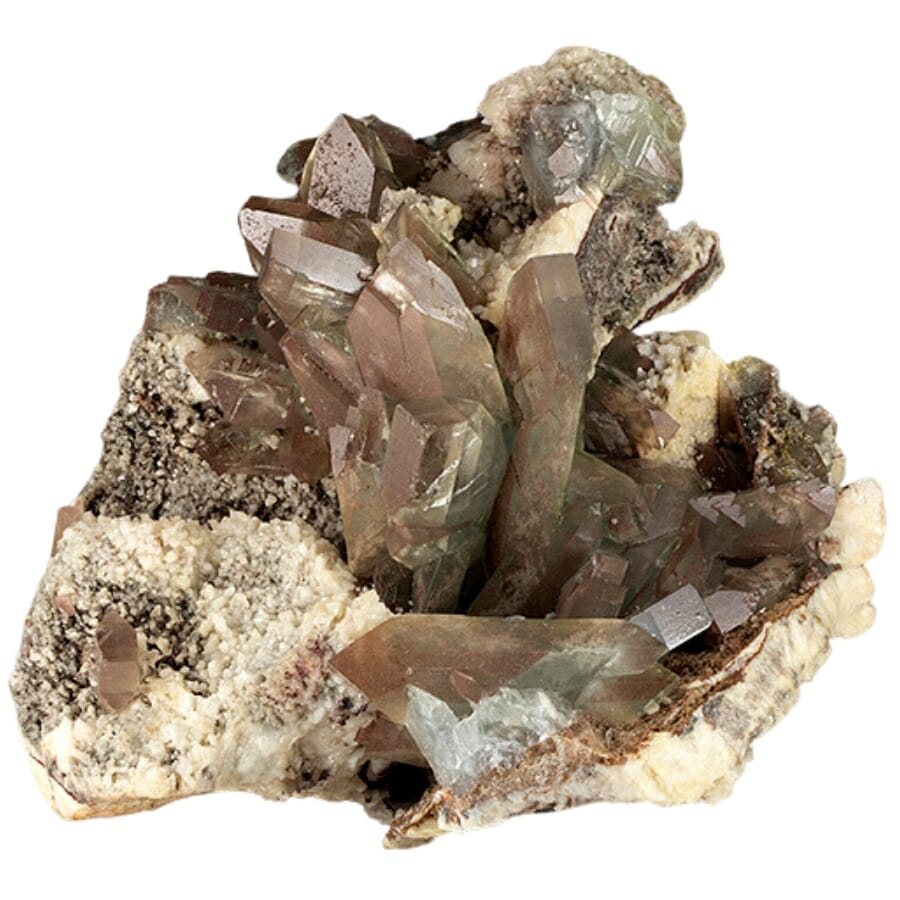
Barite sure knows how to make an entrance with its heavy weight! This mineral is much heavier than you’d expect for its size. It comes in various colors such as clear, white, blue, yellow, or brown. Sometimes, when you look at it closely, it has a cool glassy shine.
This mineral can form in various places, such as hot springs, the sea, and even in veins inside rocks. When the substances that make barite get into deep-ground solutions, it forms crystals.
Because it’s so dense and heavy, it’s used in things that need added weight. Think of those mud mixtures used in drilling oil wells. It helps keep the drill bit steady by making the mud heavy. Its high density is also a contrast agent in X-rays and CT scans.
In the grand tapestry of minerals, barite is both practical and pretty. It’s a cool combination of nature’s artistry and usefulness.
Where you can find Barite in North Carolina
Barite can be found in these areas in North Carolina:
- Crowder’s Mountain State Park
- Reed Gold Mine
Cerussite
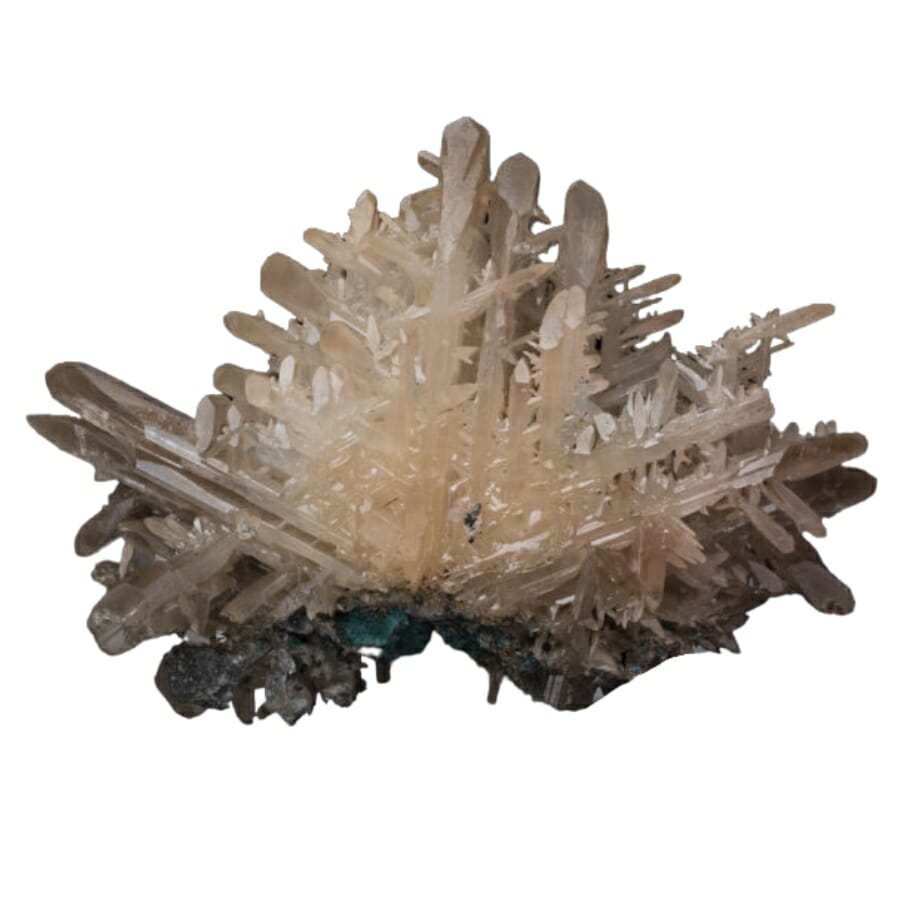
Cerussite is a mineral that stands out because it has sparkly crystals that can look as clear as glass or shimmer with a hint of color. This mineral often takes on fantastic shapes that catch the eye of anyone who sees them. You might even see twin crystals, made of two crystals that grow together uniquely!
It’s commonly found in areas where lead ores, like galena, are breaking down. This usually happens near the Earth’s surface, in the oxidized zone of lead ore deposits.
Lead ores change over time with the help of water and air to become minerals like cerussite. It’s how nature reuses old rocks and gives them a new, sparkly life.
For many, it’s all about its beauty and brilliance. When light hits a clear cerussite crystal just right, it dances with bright sparkles. This makes it a favorite for mineral collectors.
Plus, it has a special ability: it’s very flexible with light, which means it breaks light into several rays, making it even more stunning.
Cerussite is a testament to how the Earth can transform something ordinary into a true work of art. It’s a gem of a reminder about the magic tucked away beneath our feet!
Where you can find Cerussite in North Carolina
You can find unique pieces of cerussite in North Carolina, especially on the western slope of Davis Mountain.
Kyanite
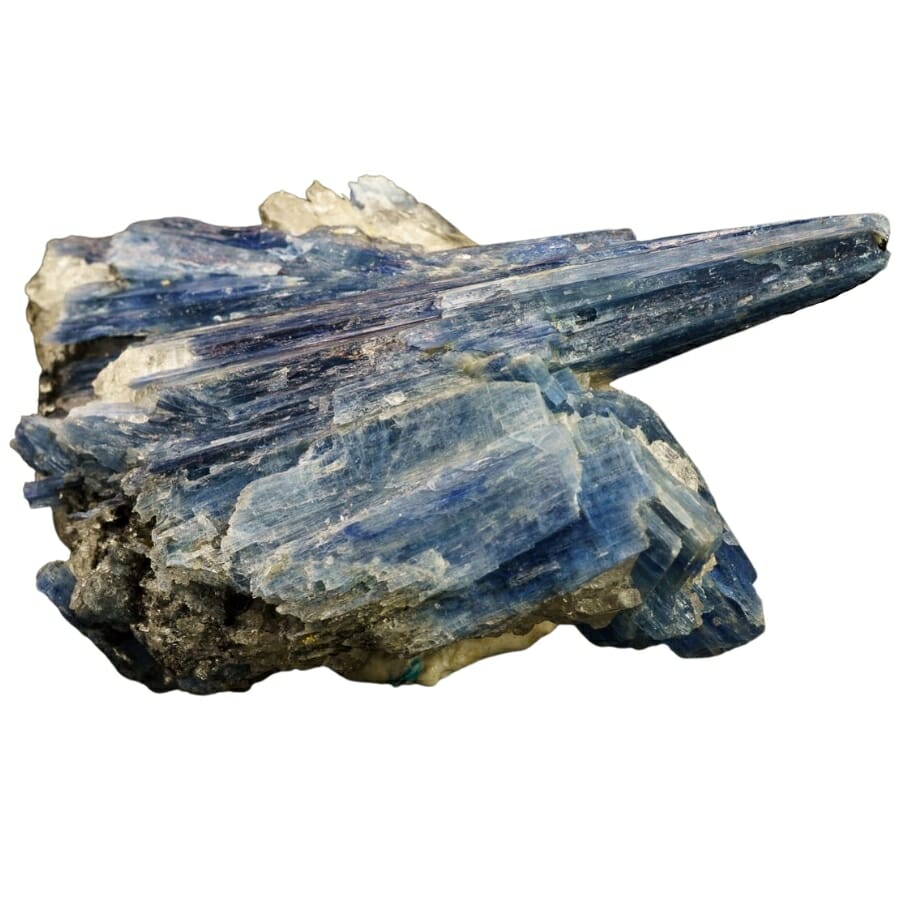
Kyanite is a fascinating stone, primarily because its unique blue color reminds many of a clear blue sky on a sunny day. This mineral can be light blue to dark blue, and its crystals often have white lines.
It’s made when there is a lot of pressure and heat, usually deep in the Earth’s crust. Its shape is unique because it can stand up to different conditions. In simple terms, the heat and pressure inside the Earth cook up this mineral, making it out of other materials.
It’s often used in rings and pendants, but it’s also used in other jewelry. It also has some valuable properties that make it useful in some industries. It can be used in things that handle high temperatures, like ceramics.
From the center of the Earth to jewelry, kyanite is a remarkable mineral that shows how beautiful and useful nature is.
Due to its anisotropy, it’s often used as a refractory material in high-temperature environments such as furnaces and kilns.
From the center of the Earth to jewelry, kyanite is a remarkable mineral that shows how beautiful and useful nature is.
Where you can find Kyanite in North Carolina
You can locate kyanite in the following areas:
- Cherokee Ruby and Sapphire Mine
- Cowee Creek
- Crowder’s Mountain State Park
- Lookout Mountain
- Ray Mica Mine
Lepidolite
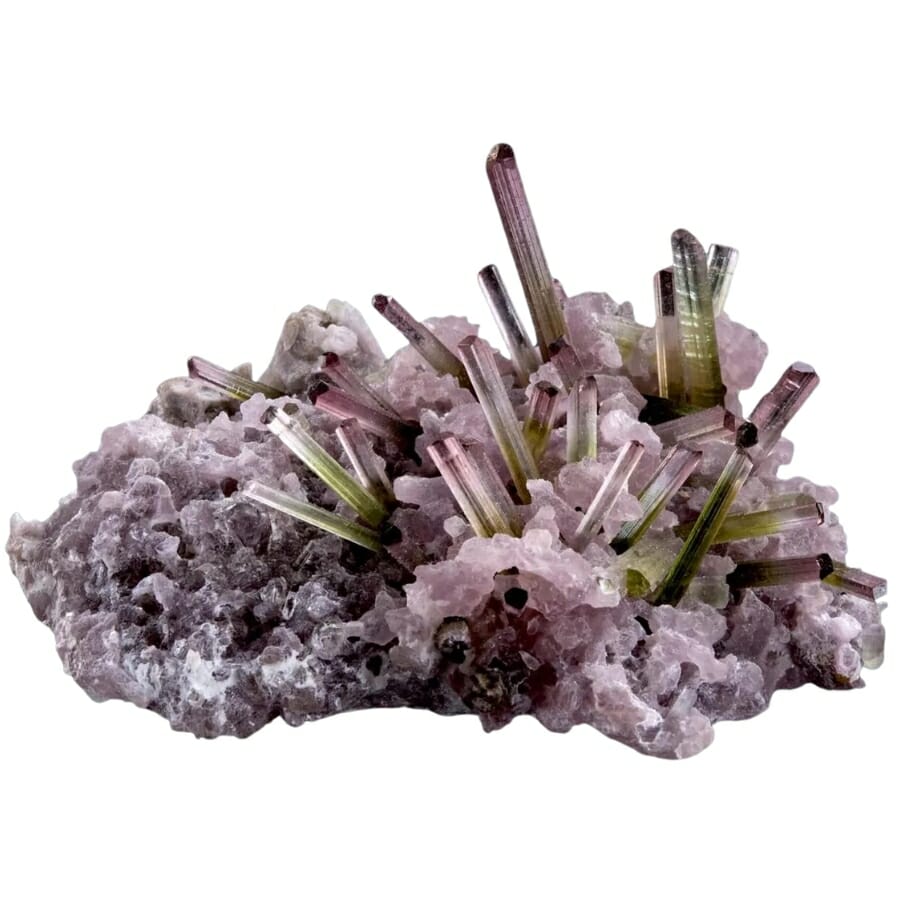
Lepidolite is a beautiful mineral that often stands out because of its beautiful purple, pink, and red colors. This mineral looks shiny and flaky because it has tiny bits of mica in it. It’s easy to think of it as “nature’s glitter” sometimes.
It forms from the cooling of magma or sedimentary rocks. The magic starts deep within the Earth. As magma cools and solidifies, various minerals start to grow.
It likes to form with other minerals like quartz, feldspar, and tourmaline. Over time, these minerals work their way to the surface of the Earth, where we find them.
Lepidolite contains a tiny bit of lithium. That’s the same stuff used in rechargeable batteries for our gadgets. But don’t rush to break apart your lepidolite stone to charge your phone; we have other ways to get lithium!
And, of course, its beautiful colors make it a top choice for jewelry and decoration. Imagine having a piece of Earth’s glitter to wear or display!
Where you can find Lepidolite in North Carolina
It’s not hard to find lepidolite in North Carolina, especially in these locations:
- Area near the county border of Inez
- Fowler Farm
Spodumene
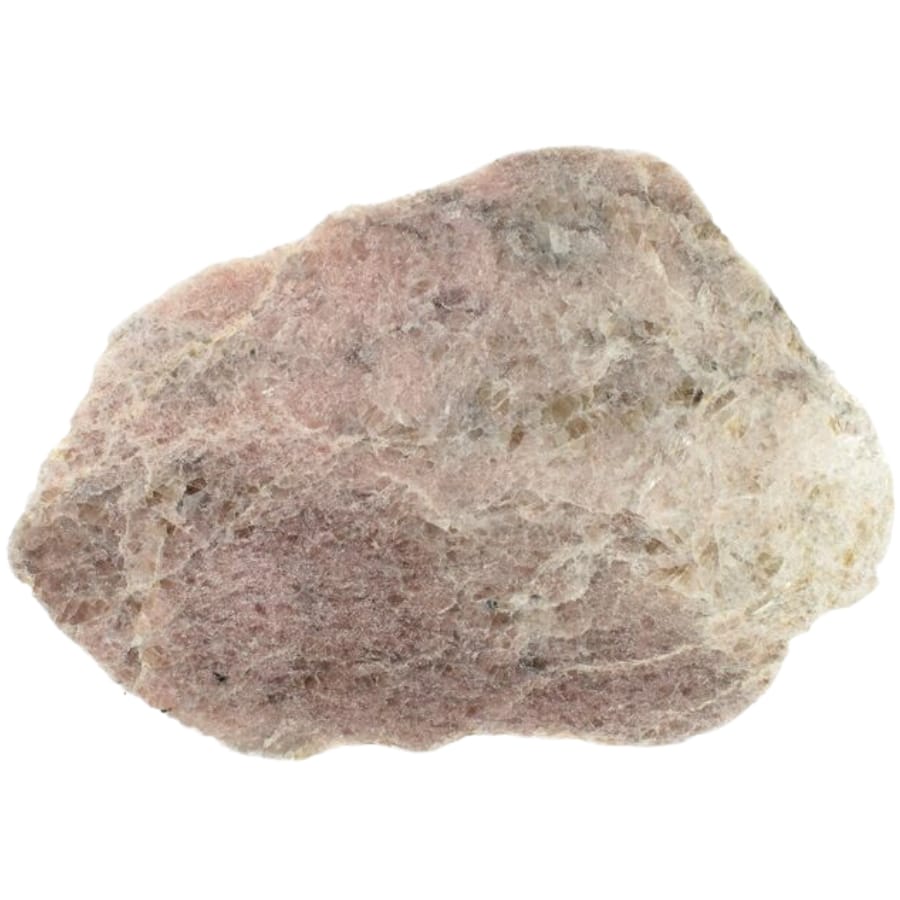
Spodumene is a real show-stopper in the world of minerals! With vibrant shades ranging from clear and colorless to deep green and pink, this gem is a feast for the eyes.
The green spodumene is called hiddenite, and the pink one is called kunzite. Each color is beautiful and charming in its way.
Spodumene forms from cooling magma deep within the Earth. As magma cools and hardens, various minerals begin to grow, and spodumene is one of these minerals. It often grows with other beautiful crystals, such as quartz and tourmaline.
It also contains lithium. Yes, the same element used in batteries powers many of our devices. This makes it incredibly valuable for technological advances and energy solutions.
Spodumene is also beloved in the world of jewelry. The vibrant kunzite and hiddenite varieties are often shaped, polished, and set into stunning pieces that catch the light brilliantly.
Many people love spodumene crystals, either because they are functional or beautiful. They are an excellent example of how the Earth makes terrific things for us to enjoy and use.
Where you can find Spodumene in North Carolina
You can visit the following places for unique pieces of spodumene:
- Foote Mine and other mines near Kings Mountain
- The general area of Stony Point
- Poplar Springs
The Most Valuable Rocks and Minerals in North Carolina
Not only are these fantastic specimens worth a lot of money, but they also tell stories about the Earth’s past. Let’s take a look at some of the most valuable rocks and minerals in North Carolina.
Emerald

Emeralds are nature’s own green fireworks display. It’s one of the most popular gemstones in the world because of its bright, vivid green colors. Every time you look at one, it’s as if you’re peering into a lush, tropical rainforest.
It belongs to the beryl family of minerals, just like aquamarine. But what gives the gem its distinctive green color? It’s all thanks to small amounts of chromium and sometimes vanadium mixed in.
Let’s take a trip deep inside the Earth to discover how emeralds come to life. When hot magma from deep within the Earth rises and cools, it forms rocks.
As these rocks change over time, with heat and pressure, beryl minerals can form. If there’s chromium or vanadium around, bam! That beryl turns into the green wonder we call emerald.
Their dazzling green shades symbolize renewal and growth, just like spring. Throughout history, royalty has worn emeralds, signifying power and wealth. Today, whether it’s in a necklace, ring, or crown, emeralds have a timeless appeal that captures hearts and imaginations.
With their rich history, stunning beauty, and positive vibes, it’s no wonder emeralds shine so bright in the world of gems!
Where you can find Emerald in North Carolina
Emerald is abundant in these locations:
- Big Crabtree Mountain
- Crabtree Emerald Mine
- Emerald Hollow Mine
- Spruce Pine
- Thermal City Gold Mine
Hiddenite
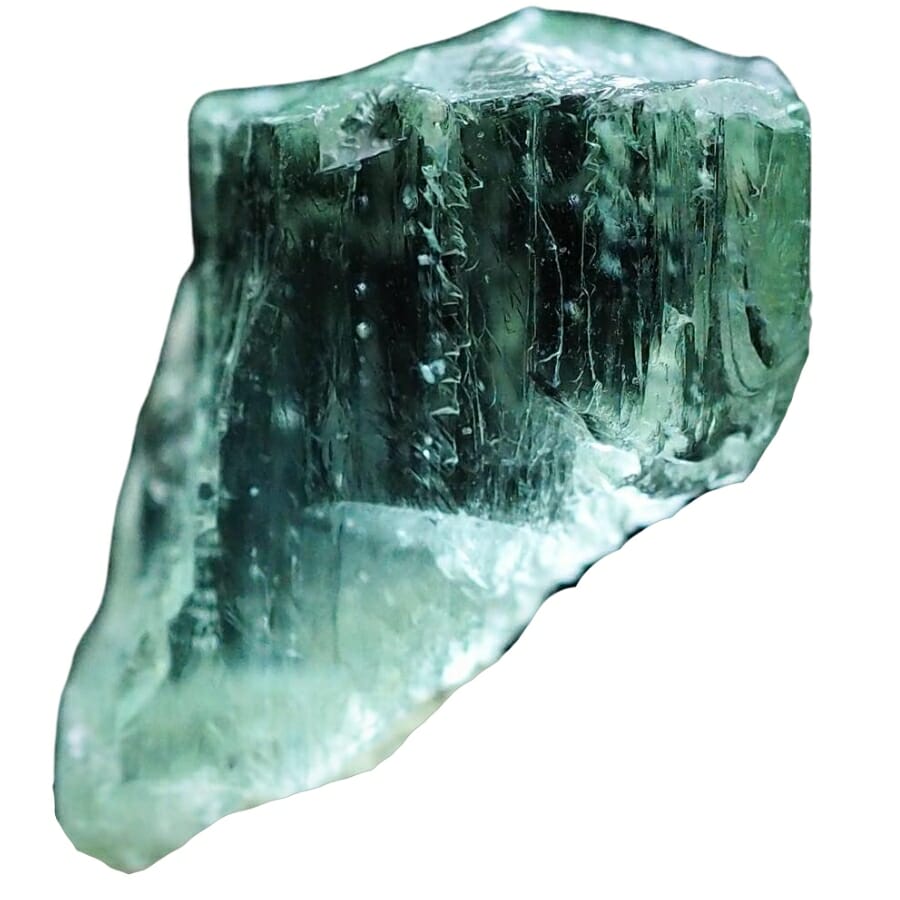
Hiddenite! Now there’s a gem that dances with color and mystery. This lovely stone is a variety of mineral spodumene, and it has a stunning green color that can range from a pale, light shade to a richer, deeper green. Imagine the fresh green leaves of spring, and you’ll get a sense of Hiddenite’s beauty.
It forms in granite pegmatites, which are special rocks with interlocking crystals. It gets its beautiful green color when some things, like chromium, are around when spodumene is made. It’s how minerals are used by nature to make art.
Hiddenite is named after the mineralogist W.E. Hidden, who was the first to notice its unique properties. Its colors range from soft pastel green to bright shades that look like new leaves in spring.
Another exciting aspect is that it can show different colors when viewed from various angles, a feature known as pleochroism. All these wonders wrapped up in one gem make hiddenite a treasure for gem lovers and collectors everywhere!
Where you can find Hiddenite in North Carolina
Hiddenite can be found in many places, among them are:
- Farms in the Hiddenite area
- Many old area mines of Hiddenite
How to Identify The Rocks and Minerals You Find
Identifying rocks and minerals can be exciting, but it requires a combination of observation, knowledge, and sometimes specialized tools.
It doesn’t have to be hard or cost a lot of money. You can get closer to figuring out what rocks and gems are by using simple tools you can find around the house.
Take a look at its color
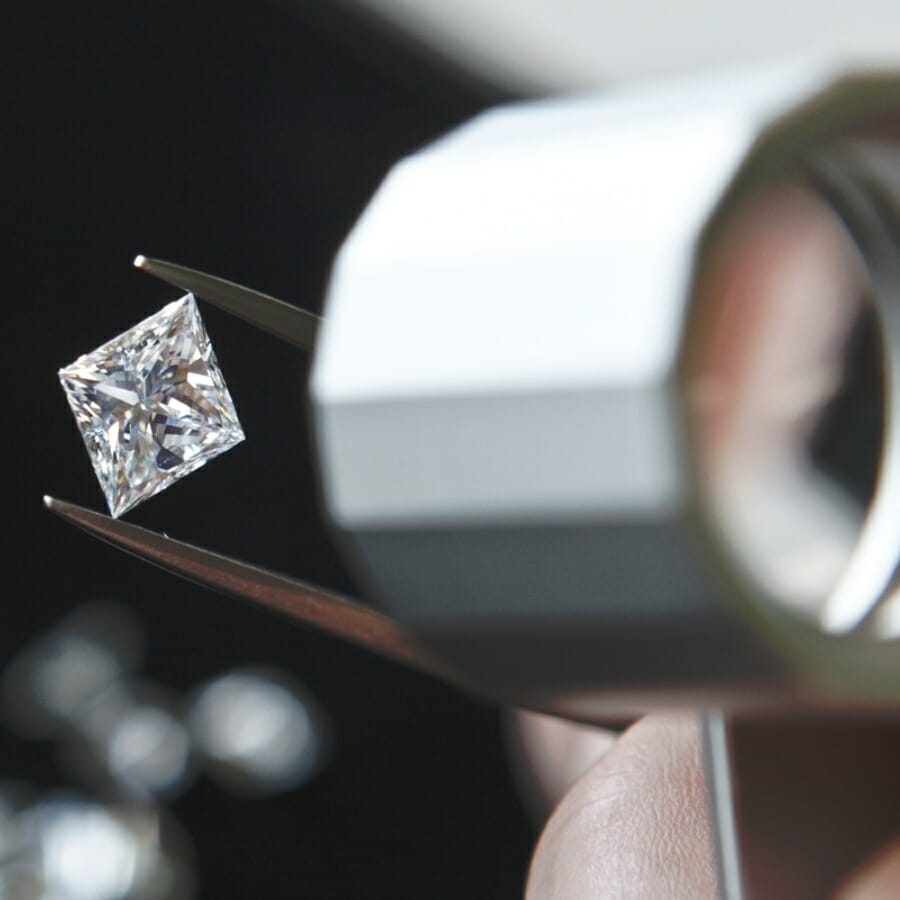
Observe the rock or mineral in natural lighting conditions. This provides the most accurate representation of its color. Try to examine it outdoors or near a window where you can benefit from natural sunlight.
If natural light isn’t available, use a well-lit indoor area. Avoid using colored lights, as they can distort the perception of color.
Place the rock or mineral on a plain, white background. This helps minimize color reflections from surrounding surfaces and enhances your ability to see the true color.
Observe the rock or mineral from different angles. Tilt it and rotate it to see if the color changes depending on how the light interacts with its surface. Compare the rock or mineral’s color to objects with known colors. Hold it next to items of various colors to help determine the closest match.
Remember that color can vary based on the lighting conditions and the presence of impurities or mineral inclusions. While color is an important characteristic, it’s just one of several factors in identifying rocks and minerals.
Perform a hardness test
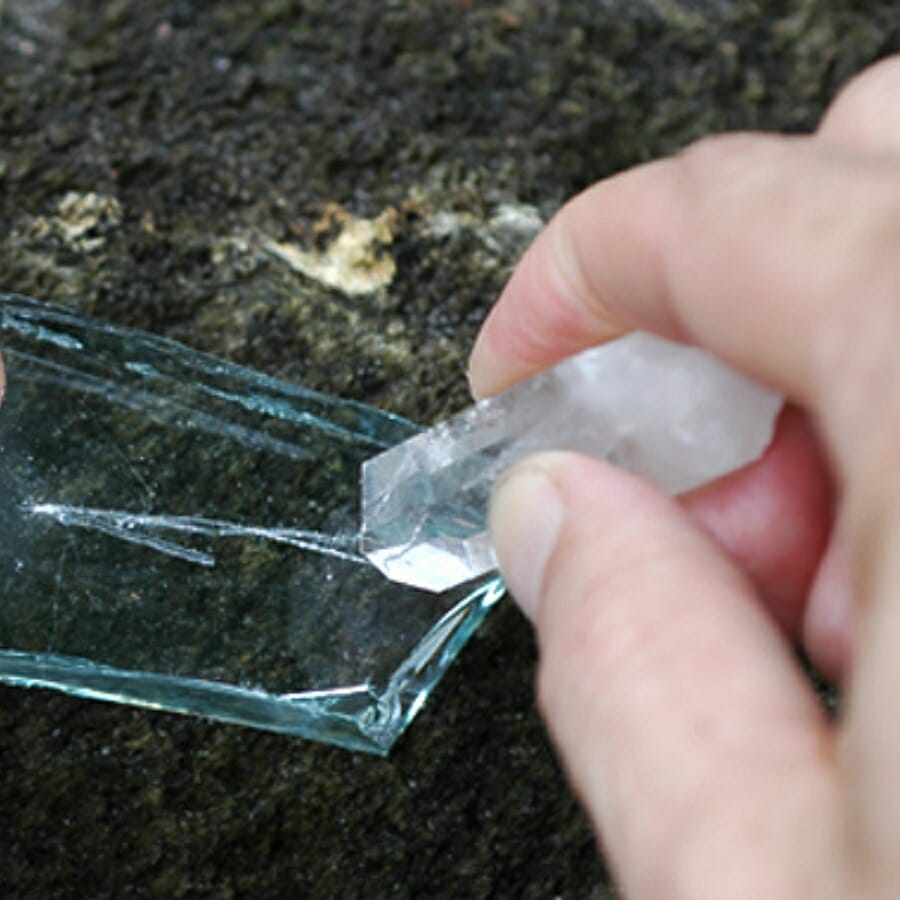
Conducting a hardness test on a rock or mineral involves determining how easily other materials can scratch it. The Mohs Scale of Mineral Hardness, developed by Friedrich Mohs in 1812, is widely used to measure hardness. The scale ranges from 1 (softest) to 10 (hardest).
Start by attempting to scratch the rock or mineral with each known hardness material. Based on the results of the scratches, compare your observations to the Mohs Scale.
For instance, if the mineral scratches the penny but not the glass, its hardness is between 3.5 and 5.5. Continue comparing until you find the material that scratches the mineral but is not scratched by it.
It’s important to note that the Mohs Scale provides a relative measure of hardness, not an absolute value. Additionally, some minerals may exhibit different hardness on different crystal faces.
Conducting a hardness test can be a helpful preliminary step in identifying minerals, but it’s best used in conjunction with other tests and observations to ensure accurate identification.
Check if it’s magnetic
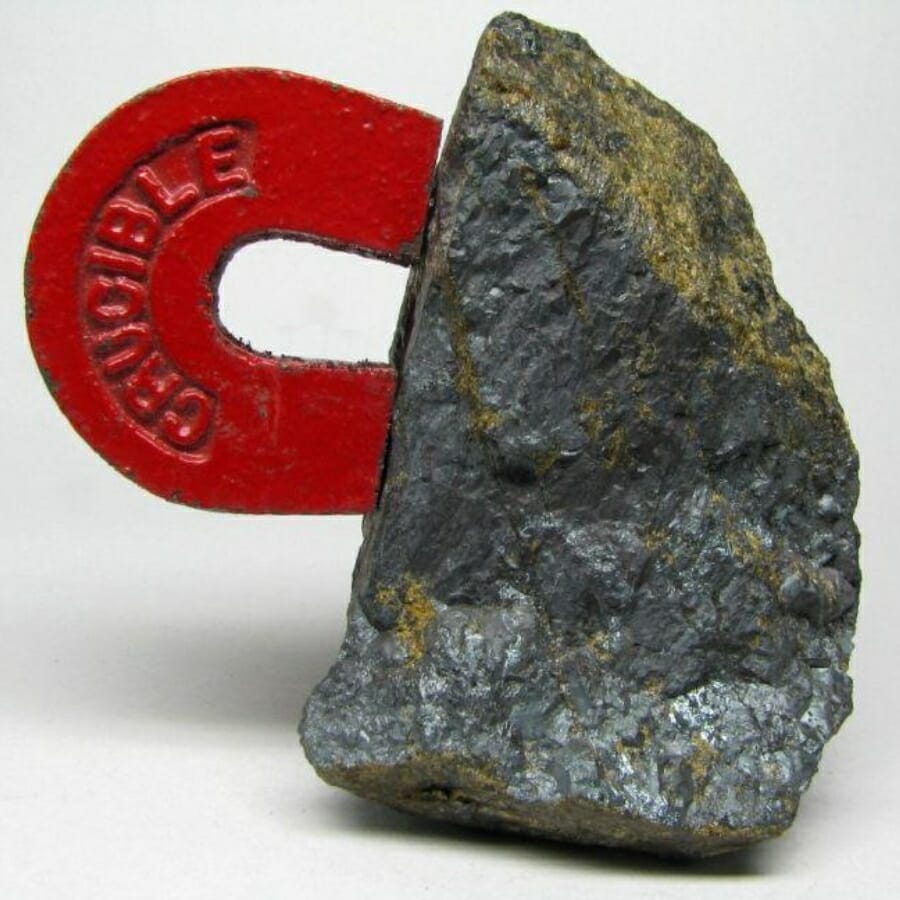
The simplest way to test for magnetism is to use a magnet. You can use a common refrigerator magnet or a stronger neodymium magnet for better results. Hold the magnet close to the rock or mineral and observe whether there is any attraction or movement.
If the rock or mineral is attracted to the magnet and sticks to it, it is magnetic. If there is no attraction, the rock or mineral is not magnetic. If the attraction is weak, the magnetic properties may be faint.
Test different sides or parts of the rock or mineral with the magnet. Due to their crystal structure, some rocks or minerals may only be weakly magnetic on certain sides.
Ensure that there are no other materials around that could be influencing the magnetism test. Metal objects or other magnets in the vicinity can affect the results.
It’s important to note that not all rocks and minerals are magnetic. Magnetism is primarily exhibited by minerals containing iron or certain metallic elements, such as magnetite.
However, other minerals may exhibit weak magnetic properties that are not easily detectable with simple tests. If you’re attempting to identify a specific mineral, it’s a good idea to consult mineral identification resources or experts to confirm its magnetic properties.
Do a streak test
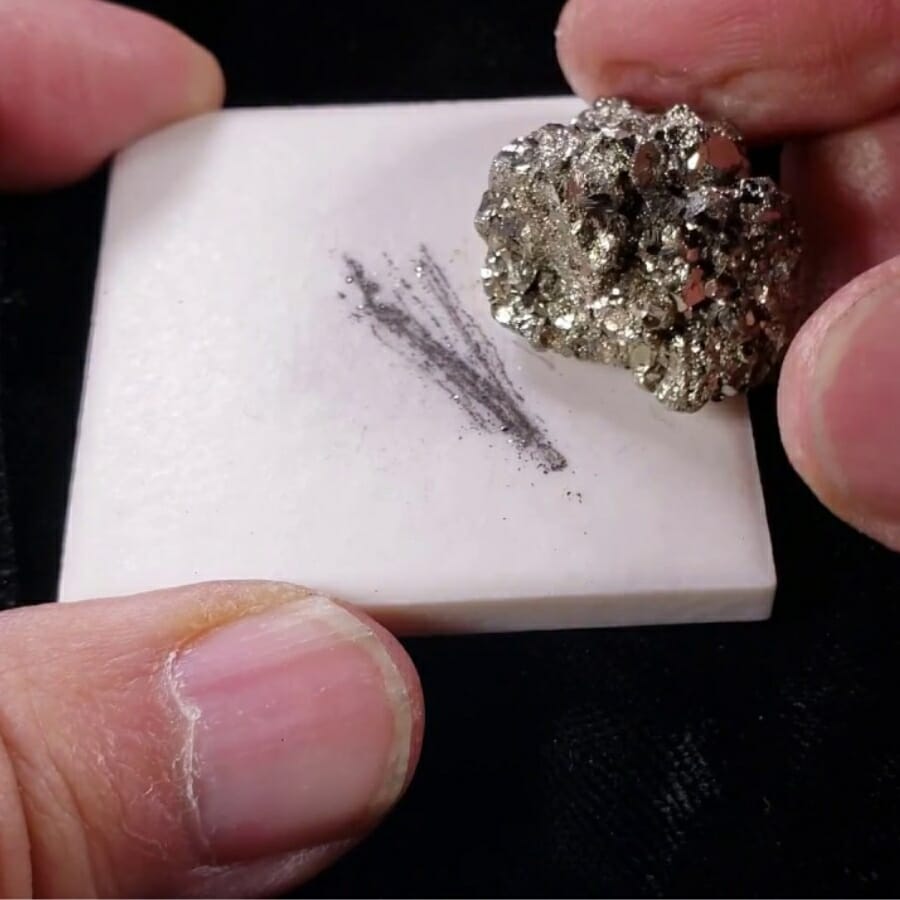
Performing a streak test involves rubbing the rock or mineral against an unglazed porcelain streak plate to observe the color of the powdered streak left behind.
This can provide valuable information about the mineral’s color in powdered form, which may differ from its external color.
After rubbing the mineral on the streak plate, examine the color of the streak left behind on the streak plate. Note that the color of the streak can sometimes be different from the external color of the mineral. This is due to factors like impurities or changes in oxidation state.
Streak tests are most effective for minerals with a hardness of around 6 or less on the Mohs Scale. Harderminerals may not leave a visible streak. If a mineral is harder than the streak plate (typically around 6.5 to 7 on the Mohs Scale), the streak plate may get scratched, and the test won’t work well.

